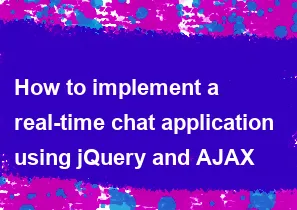How to implement a real-time chat application using jQuery and AJAX

To implement a real-time chat application using jQuery and AJAX, you can follow these general steps. Keep in mind that real-time applications often benefit from more advanced technologies like WebSockets, but this example will use AJAX for simplicity.
- HTML Structure: Create the basic HTML structure for your chat application.
html<!DOCTYPE html>
<html lang="en">
<head>
<meta charset="UTF-8">
<meta name="viewport" content="width=device-width, initial-scale=1.0">
<title>Real-time Chat App</title>
</head>
<body>
<div id="chat-box">
<div id="chat-messages"></div>
<input type="text" id="message-input" placeholder="Type your message...">
<button id="send-btn">Send</button>
</div>
<script src="https://code.jquery.com/jquery-3.6.4.min.js"></script>
<script src="script.js"></script>
</body>
</html>
- CSS Styling (Optional): Style your chat application using CSS. This step is optional but improves the user experience.
css#chat-box {
width: 300px;
margin: 20px auto;
border: 1px solid #ccc;
padding: 10px;
}
#chat-messages {
height: 200px;
overflow-y: scroll;
border-bottom: 1px solid #ccc;
}
#message-input {
width: 70%;
padding: 5px;
}
#send-btn {
padding: 5px;
cursor: pointer;
}
- JavaScript (script.js): Create a JavaScript file to handle the logic of your chat application.
js$(document).ready(function () {
// Function to load and display messages
function loadMessages() {
$.ajax({
url: 'get_messages.php', // Replace with your server endpoint to retrieve messages
method: 'GET',
success: function (data) {
$('#chat-messages').html(data);
// Scroll to the bottom of the chat messages
$('#chat-messages').scrollTop($('#chat-messages')[0].scrollHeight);
}
});
}
// Load initial messages
loadMessages();
// Set interval to refresh messages every 2 seconds
setInterval(function () {
loadMessages();
}, 2000);
// Send message when the send button is clicked
$('#send-btn').click(function () {
var message = $('#message-input').val();
// Send the message to the server for processing
$.ajax({
url: 'send_message.php', // Replace with your server endpoint to send messages
method: 'POST',
data: { message: message },
success: function () {
// Clear the input field after sending the message
$('#message-input').val('');
// Reload messages to display the new message
loadMessages();
}
});
});
});
Server-Side Script (send_message.php and get_messages.php): Create server-side scripts to handle sending and retrieving messages. This example uses PHP, but you can use any server-side technology you're comfortable with.
send_message.php:
php<?php
// Replace with your database connection code if necessary
if ($_SERVER['REQUEST_METHOD'] === 'POST') {
$message = $_POST['message'];
// Save the message to the database or any other storage mechanism
// Respond with success (you can handle errors based on your requirements)
echo 'success';
}
?>
get_messages.php:
php<?php
// Replace with your database connection code if necessary
// Retrieve and display the chat messages from the database or storage
// Format the messages as HTML and echo them
echo '<div class="message">User 1: Hello</div>';
echo '<div class="message">User 2: Hi there</div>';
// Add more messages as needed
?>
Adjust the code according to your specific needs, and don't forget to replace the placeholder URLs with your actual server endpoints. Also, consider implementing security measures such as input validation and authentication depending on your application's requirements.
-
Popular Post
- How to optimize for Google's About This Result feature for local businesses
- How to implement multi-language support in an Express.js application
- How to handle and optimize for changes in mobile search behavior
- How to handle CORS in a Node.js application
- How to use Vue.js with a UI framework (e.g., Vuetify, Element UI)
- How to configure Laravel Telescope for monitoring and profiling API requests
- How to create a command-line tool using the Commander.js library in Node.js
- How to implement code splitting in a React.js application
- How to use the AWS SDK for Node.js to interact with various AWS services
- How to use the Node.js Stream API for efficient data processing
- How to implement a cookie parser middleware in Node.js
- How to implement WebSockets for real-time communication in React
-
Latest Post
- How to implement a dynamic form with dynamic field styling based on user input in Next.js
- How to create a custom hook for handling user interactions with the browser's device motion in Next.js
- How to create a custom hook for handling user interactions with the browser's battery status in Next.js
- How to implement a dynamic form with dynamic field visibility based on user input in Next.js
- How to implement a dynamic form with real-time collaboration features in Next.js
- How to create a custom hook for handling user interactions with the browser's media devices in Next.js
- How to use the useSWRInfinite hook for paginating data with a custom loading indicator in Next.js
- How to create a custom hook for handling user interactions with the browser's network status in Next.js
- How to create a custom hook for handling user interactions with the browser's location in Next.js
- How to implement a dynamic form with multi-language support in Next.js
- How to create a custom hook for handling user interactions with the browser's ambient light sensor in Next.js
- How to use the useHover hook for creating interactive image zoom effects in Next.js